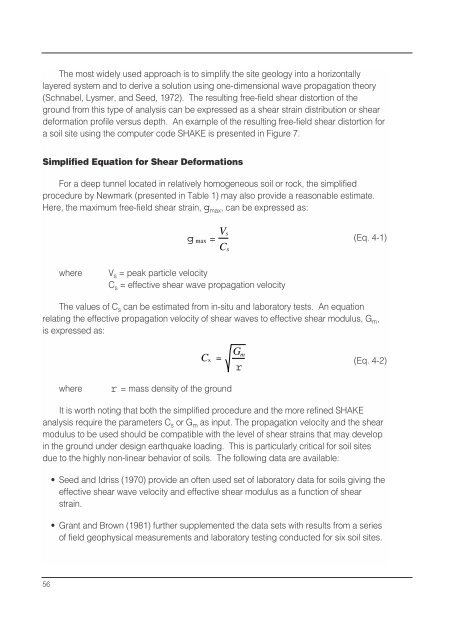Seismic Design of Tunnels - Parsons Brinckerhoff
Seismic Design of Tunnels - Parsons Brinckerhoff
Seismic Design of Tunnels - Parsons Brinckerhoff
You also want an ePaper? Increase the reach of your titles
YUMPU automatically turns print PDFs into web optimized ePapers that Google loves.
The most widely used approach is to simplify the site geology into a horizontally<br />
layered system and to derive a solution using one-dimensional wave propagation theory<br />
(Schnabel, Lysmer, and Seed, 1972). The resulting free-field shear distortion <strong>of</strong> the<br />
ground from this type <strong>of</strong> analysis can be expressed as a shear strain distribution or shear<br />
deformation pr<strong>of</strong>ile versus depth. An example <strong>of</strong> the resulting free-field shear distortion for<br />
a soil site using the computer code SHAKE is presented in Figure 7.<br />
Simplified Equation for Shear Deformations<br />
For a deep tunnel located in relatively homogeneous soil or rock, the simplified<br />
procedure by Newmark (presented in Table 1) may also provide a reasonable estimate.<br />
Here, the maximum free-field shear strain, g max , can be expressed as:<br />
g max = V s<br />
C s<br />
(Eq. 4-1)<br />
where<br />
V s = peak particle velocity<br />
C s = effective shear wave propagation velocity<br />
The values <strong>of</strong> C s can be estimated from in-situ and laboratory tests. An equation<br />
relating the effective propagation velocity <strong>of</strong> shear waves to effective shear modulus, G m ,<br />
is expressed as:<br />
C s =<br />
G m<br />
r<br />
(Eq. 4-2)<br />
where<br />
r = mass density <strong>of</strong> the ground<br />
It is worth noting that both the simplified procedure and the more refined SHAKE<br />
analysis require the parameters C s or G m as input. The propagation velocity and the shear<br />
modulus to be used should be compatible with the level <strong>of</strong> shear strains that may develop<br />
in the ground under design earthquake loading. This is particularly critical for soil sites<br />
due to the highly non-linear behavior <strong>of</strong> soils. The following data are available:<br />
• Seed and Idriss (1970) provide an <strong>of</strong>ten used set <strong>of</strong> laboratory data for soils giving the<br />
effective shear wave velocity and effective shear modulus as a function <strong>of</strong> shear<br />
strain.<br />
• Grant and Brown (1981) further supplemented the data sets with results from a series<br />
<strong>of</strong> field geophysical measurements and laboratory testing conducted for six soil sites.<br />
56
















